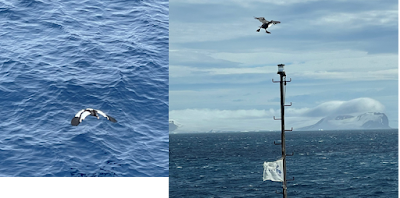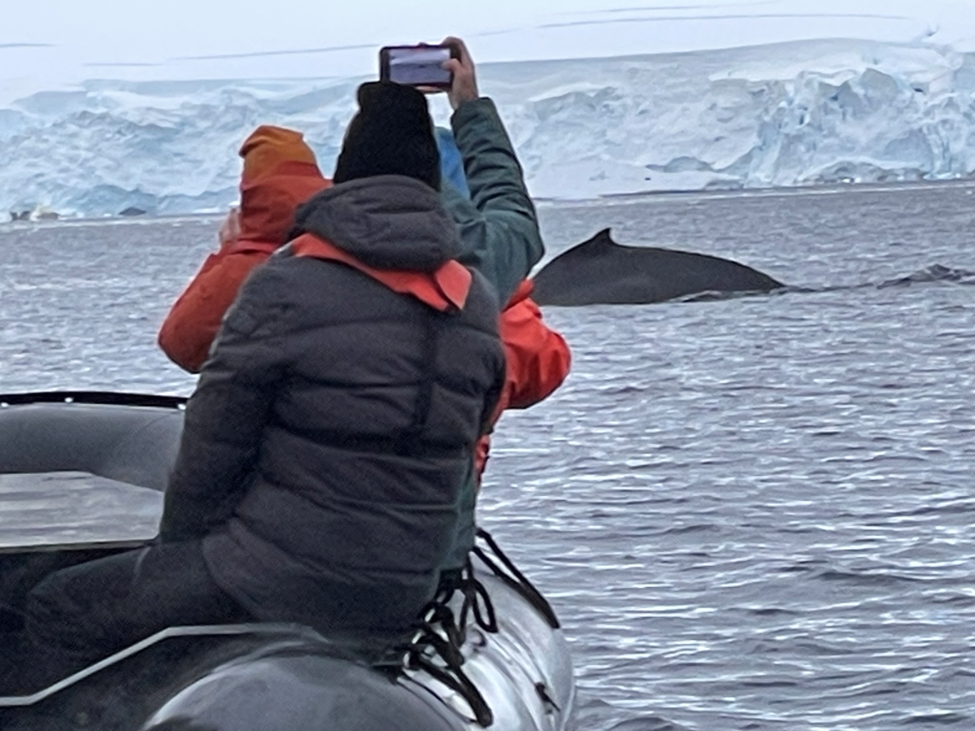 Tue 2/27. We boarded our ship the M/V Ushuaia at 3:30. We
immediately made friends in line with Matt. The ship departed the Port Ushuaia
at 5pm in calm waters with light wind. The first order of business was the
welcome and introductions, followed by a safety talk and evacuation drill. The
passengers are organized in two groups based on room numbers, odd or even.
There were lots of reminders about safety protocol in the Drake Passage, which
is notoriously rough water. This vessel was built as a NOAA research vessel in
the sixties. Rumor has it it was also used by the CIA. It is very well maintained. At 90 passengers (87 on our voyage), it is the
smallest and oldest cruise ship touring Antarctica. It is also the only one
that is owned and registered in Argentina and provides lectures in both English
and Spanish. Because it was originally built as a research vessel it doesn’t
have all the tourist-class amenities of a larger ship. We were gifted an
upgrade to a private suite: two single beds, not bunks, and an ensuite
bathroom.
Tue 2/27. We boarded our ship the M/V Ushuaia at 3:30. We
immediately made friends in line with Matt. The ship departed the Port Ushuaia
at 5pm in calm waters with light wind. The first order of business was the
welcome and introductions, followed by a safety talk and evacuation drill. The
passengers are organized in two groups based on room numbers, odd or even.
There were lots of reminders about safety protocol in the Drake Passage, which
is notoriously rough water. This vessel was built as a NOAA research vessel in
the sixties. Rumor has it it was also used by the CIA. It is very well maintained. At 90 passengers (87 on our voyage), it is the
smallest and oldest cruise ship touring Antarctica. It is also the only one
that is owned and registered in Argentina and provides lectures in both English
and Spanish. Because it was originally built as a research vessel it doesn’t
have all the tourist-class amenities of a larger ship. We were gifted an
upgrade to a private suite: two single beds, not bunks, and an ensuite
bathroom. The seas picked up a bit when we entered the Drake Passage around midnight, winds 10-12 kts. The passengers, by contrast, were not tranquil: lots of camaraderie, bon homme, tall tales, accomplishments and travails.
We 2/28. Up for breakfast at 8. The seas were unusually mild for Drake Passage. The captain opened more of the decks for us to be outside. 10am lecture on the history of the Antarctic Treaty. The wind came up and the seas got rougher as the day went on, so the captain closed the decks again. The afternoon lecture was about birds. We spent some time up on the bridge talking shop with the first officer. It was sunny and the petrels were flying. We saw Southern Giant and Storm Petrels and a Wandering Albatross. The sea is the darkest blue with white-white strands. Late in the day all the officers gathered on the bridge for a little birthday celebration for the captain. We went down and dined with a Japanese couple.The boat has a lot of motion. It is entertaining watching us
all adapt to walking in a weaving, leaning, up hill down hill pattern. We are
under strict orders to always have two hands for the grab bars, especially on
the stairs and around the doors, and always wear closed-toe shoes. The crew all
say this has been the easiest, calmest crossing for the Drake Passage they have
seen. Expect it to be more challenging next time.
At 5:15 pm we passed through the South Shetland Islands with
calm water, and mountains and tidewater glaciers flanking our port. The
icebergs were as big as Alaskan villages, breathing whiteness in the afternoon
sun, contrasting with the black backs of breathtaking whales, rock and glacier
of all forms. Deep blues against the reefs and shallows around the Islas
Livingston, Greenwhich and Roberts.


Sat 3/2. We got a wakeup call at 5:30am so we all could all
go out on deck to see the passage through the channel into the caldera Port
Foster where we anchored. It is an active volcano. There are extensive ruins of
an old whaling station destroyed by eruptions in 1967 and 1969. It would be
interesting and quiet to kayak around the shore.
We continued on to anchor at Hannah Point where we had a fabulous excursion! Mike and I were in the first Zodiac to reach shore, and one of the last to leave. The place with thick with penguins and noisy seals. As we walked we encountered HUGE Elephant seals lying in piles on the beach. Some were snoring. Some were sparring and grunting. There was also a nice swimming beach for those of us hearty enough to indulge. Mike and I didn't.
Sun 3/3. By morning we were anchored at Hydrurga Rocks for another outing. There were lots of Chinstrap penguins and Fur seals, one Crabeater seal and two Weddell seals. We had spectacular views of glaciers, glaciated peaks and glacial walls at water’s edge. Less wind and more sun. We were toasty warm in five to six layers of clothing, though walking on the firn ice our toes got cold. We preferred rock-hopping.
Bancroft Bay was too windy, so we went up Gerlache Strait heading for several small coves for exploring in the Zodiacs. The max speed in the Strait is 9.5 knots because of the presence of whales: we saw three Humpbacks! We hung out near them for a long time. Another cruise ship is also in view. One of the whales is young and a lot smaller. The scenery is absolutely ethereal: sea flanked by white summits and walls of ice. We saw a whale breach spectacularly near the ship. Over the next hour we saw nearly 20 more whales. We did a one-hour Zodiac tour in a glacial fjord on Brabant Island, with LOTS of spectacular icebergs. It was a sculpture garden with glaciers and rock mountains on the sides. It looked like a fantasy land designed by Disney animators.
We cruised down to anchor in Paradise Harbor. It is aptly named. It is absolutely still, calm and sunny. There are lots of bergy bits in the water. We saw a humpback feeding right next to the boat. We were in the second group for the Zodiac tour. The ice bergs had fabulous shapes like I’ve never seen before. I was particularly fascinated by a black berg, but we never got close enough to see it clearly. On shore we passed and waved to the staff at the Argentine Brown’s Base research station. We landed a short ways away to set foot on the continent and view the Gentoo penguins. Our fellows for whom this was their seventh continent celebrated.
Mon 3/4. It was too windy at Anna Cove so we moved our afternoon Zodiac ride to Wilhelmina Bay. Lots of whale watching, glaciers and icebergs, and birds: cormorants, petrels, terns, and a fulmar. The clouds came down heavy and dark, now spitting a few crystals of snow.
Tues 3/5. Our luck ran out. Our exceptionally good weather
has turned to socked-in, windy, rainy, cold weather more typical here. They had
to cancel our outing for this morning, but are cruising south to see if we can
find one pocket of better weather before we head back across the Drake Passage
to Ushuaia.
“Watching passengers cope with the increasing swell height
is always amusing, but it also brings on seasickness in some. Drawing the folks
who are now listless is also much easier.” –Mike
The rain stopped in the afternoon, but wind, waves and
clouds continued.
One of the interesting things about the boat is the people onboard. While most chose this ship because it is the cheapest, a few non-English speakers chose it because it it the only one with lectures in Spanish. There are people from six continents. There is a 19-member tour group from south India—they dine separately and don’t socialize much with the rest. There is a nine-member photography tour group from Italy. The rest are mostly young, independent travels, in ones and twos. Many of the young socialize and play cards together. France, UK, Scotland, Ireland, Germany, Ukraine, Australia, Taiwan, Japan, Russia, Switzerland, South Africa, Netherlands, US, Mexico, Brazil, Spain, Austria. The oldest is 83. The youngest is 24. Only 7 of us were from the US. Our best buddies are Matt who worked in offshore oil exploration, Jack, a world-travelling US State Department employee, a widowed Jewish-Austrian, and Leo and Suzi from São Paulo. Jayden is a PhD physicist at Stanford. Many are travelling widely, for months or a year. Gap years, sabbaticals, retirement, or just wanderlust-primary, working only enough to afford travel. One Italian woman had 126 countries and the seventh continent checked off of her list. Twelve others have now been on seven continents, and celebrated on the beach on the peninsula.
Wed 3/6. Transiting Drake Passage, the weather and sea
condition are typical. Some people are seasick.
Fri 3/8. It was a sunny but sad morning. We said our
goodbyes and left the boat about 8am.




















No comments:
Post a Comment